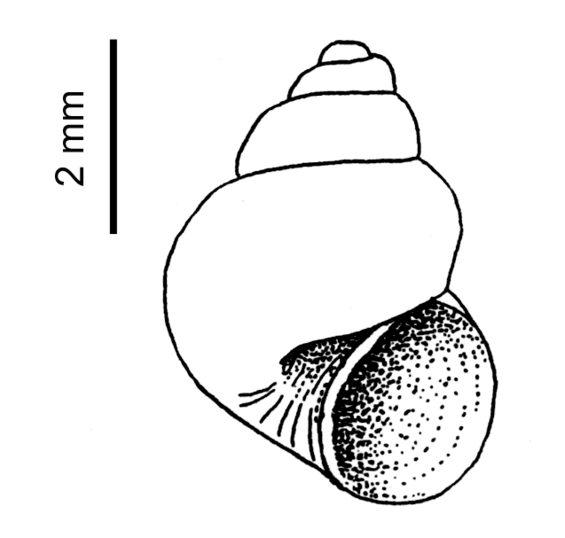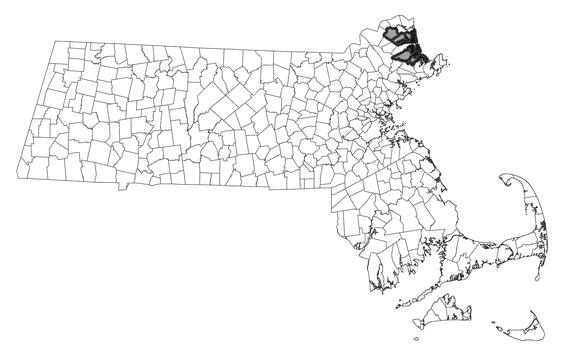- Scientific name: Floridobia winkleyi
- Species of Greatest Conservation Need (MA State Wildlife Action Plan)
- Special Concern (MA Endangered Species Act)
Description

A drawing of the New England siltsnail.
The New England siltsnail is a relatively small snail with a broadly conical shell. The spiral shell has 4.5 to 5 strongly convex whorls. It has a glossy sheen and is whitish in color when cleaned (Pilsbry 1912). The average size for adults is 4.8 mm (0.18 in) long and 3.1 mm (0.12 in) in diameter. The shell aperture (opening to shell cavity) is dextral (coiled to the right when facing observer) and has an operculum, a hardened circular structure that seals the shell. The operculum has a single obvious spiral that fans out to the perimeter. Identification of this species can be difficult because it requires knowledge of specific anatomical features of snails.
The New England siltsnail is similar in appearance to other species in the Hydrobiidae family including the more common mud amnicola (Amnicola limosa) and rare snail henscomb hydrobe (Littoridinops tenuipes) except that the shell of mud amnicola is globose and the shell of henscomb hydrobe is more conical. Identification guides sufficiently illustrate the differences among these species (Smith 2000).
Life cycle and behavior
Little is known about the life history and behavior of The New England siltsnail. The zones where these snails have been found are small, but populations are often dense. Copulation has been observed while the snails were on rocks in the water.
Distribution and abundance
The New England siltsnail is distributed in coastal waters from New York to Maine. In Massachusetts, the New England siltsnail is known from five localities that are confined to the north shore where development pressure is high. The New England siltsnail is listed under the Massachusetts Endangered Species Act as a species of Special Concern. All listed species are protected from killing, collecting, possessing, or sale and from activities that would destroy habitat and thus directly or indirectly cause mortality or disrupt critical behaviors. In addition, listed animals are specifically protected from activities that disrupt nesting, breeding, feeding, or migration.

Distribution in Massachusetts. 1999-2024. Based on records in the Natural Heritage Database.
Habitat
The New England siltsnail inhabits coastal waters that are fresh or oligohaline. Habitats include pools, creeks, marshes, and banks exposed at low tides. This snail is often found on top of mud banks waiting for water from the rising tides. It is also found on exposed mud and rocks above the waterline or submerged on emergent vegetation and other substrate. In Massachusetts, a ditch with cattails and rushes draining an oak-alder-pine swamp supports one population. Another population has been found in streams with tidal influences flowing out of a partially impounded cattail marsh (mixed Typha angustifolia and T. latifolia). Elsewhere, this snail has been found in isolated tidal pools with high salinities and in association with the saltmarsh hydrobe snail (Spurwinkia salsa). It has also been found in brackish tidal marshes dominated by cattails with patches of freshwater cordgrass (Spartina pectinata) and soft-stem bulrush (Scirpus validus).
Healthy habitats are vital for supporting native wildlife and plants. Explore habitats and learn about conservation and restoration in Massachusetts.
Threats
Threats to New England siltsnail include habitat degradation and loss from commercial and residential development, sea-level rise associated with climate change, chemical pollution from development and road runoff, and legacy effects from agriculture (e.g., ditch creation and nutrient pollution).
Conservation
Survey and monitoring
Surveys for New England siltsnail are needed at historical sites and potentially suitable locations in northeast Massachusetts. Monitoring efforts are recommended every 5 years or as needed (e.g., in response to potential disturbance events) to update its population status in Massachusetts.
Management
As with many rare species, the exact management needs for the species are unknown. However, the protection of New England siltsnail habitat is critical for species persistence in Massachusetts. Restoration and protection of saltmarsh habitats would likely benefit this species.
Research needs
The population status of New England siltsnail remains uncertain in Massachusetts. Surveys targeting historical and new sites are needed to better understand its distribution and habitat requirements. Basic life history traits (e.g., lifespan, dispersal) for this species are unknown and should be documented. Species risk assessment to sea-level rise and associated habitat loss via climate change is warranted.
References
Davis, G.M., and M. Mazurkeiwicz. 1985. Systematics of Cincinnatia winkleyi (Gastropoda: Hydrobiidae). Proceedings Academy Natural Sciences Philadelphia 137: 28-47.
Pilsbry, H.A. 1912. A new species of Amnicola. The Nautilus 26 (1):1.
Smith, D.G. 2000. Keys to the freshwater macroinvertebrates of southern New England. Published by author. Sunderland, MA. 243 pp.
Contact
| Date published: | April 11, 2025 |
|---|